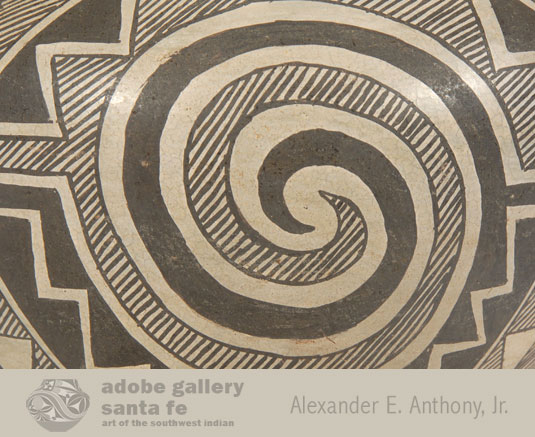Acoma Polychrome Jar with Black on White Design [SOLD]
+ Add to my watchlist Forward to Friend
- Category: Historic
- Origin: Acoma Pueblo, Haak’u
- Medium: clay, pigment
- Size: 7-⅝” height x 8-⅞” diameter
- Item # C4078V SOLD
With the arrival of the transcontinental rail line passing through New Mexico, potters at Acoma Pueblo realized a market for pottery that would generate cash for their work. The train stopped at Laguna Pueblo and Acoma potters would take their wares and join the Laguna potters in selling to the train passengers. That is one reason there is confusion concerning whether a jar was from Acoma or Laguna. Little documentation was gathered in the frantic hurry to make a purchase before the train had to continue on its way. A buyer might have made a note that the jar was purchased at Laguna Pueblo, but failed to note whether it was from an Acoma or Laguna potter, a fact of which the buyer may not have even been aware.
Although potters were busy making pottery for the daily train passing through, they also continued making magnificent pottery for their own use and for sale to the trader who had a ready market for fine pottery. This jar could have been made either for use at the pueblo or for sale to one of the many traders and museums eagerly looking for fine examples. This one probably dates to around 1940, a time when using designs from prehistoric New Mexico pottery was popular.
Acoma Pueblo potters have claimed the inherited right to use designs of the earlier Puebloan groups that lived in the early Southwest. The inspired designs of particular striking beauty are those, appropriated by 20th century Acoma potters, referred to as Tularosa Black-on-white. The original, prehistoric Tularosa vessels date from A.D.1100 to 1250.
This Acoma jar is an excellent example of the use of Tularosa patterning. The curvilinear scrolls that decorate the body are flanked on the upper and lower extremities with rectangular and triangular stepped black-on-white designs. Throughout these designs are very fine hatching lines that fill the previously undecorated white areas. As was the Tularosa tradition, the design elements are close together, solids are heavy, and hatching lines are very fine.
This is one of the most attractive styles ever produced by the Acoma potters. As black and white photographs often are stronger in appeal than color photographs (see Ansel Adams), so too are some of the black and white pottery that is often overlooked by collectors in preference to three- and four-color examples. This jar is an excellent example to illustrate this point.
Condition: this Acoma Polychrome Jar with Black on White Design is in very good condition with a solid ring sound.
Recommended Reading: Acoma & Laguna Pottery by Rick Dillingham
Provenance: from the collection of a family from Colorado

- Category: Historic
- Origin: Acoma Pueblo, Haak’u
- Medium: clay, pigment
- Size: 7-⅝” height x 8-⅞” diameter
- Item # C4078V SOLD



